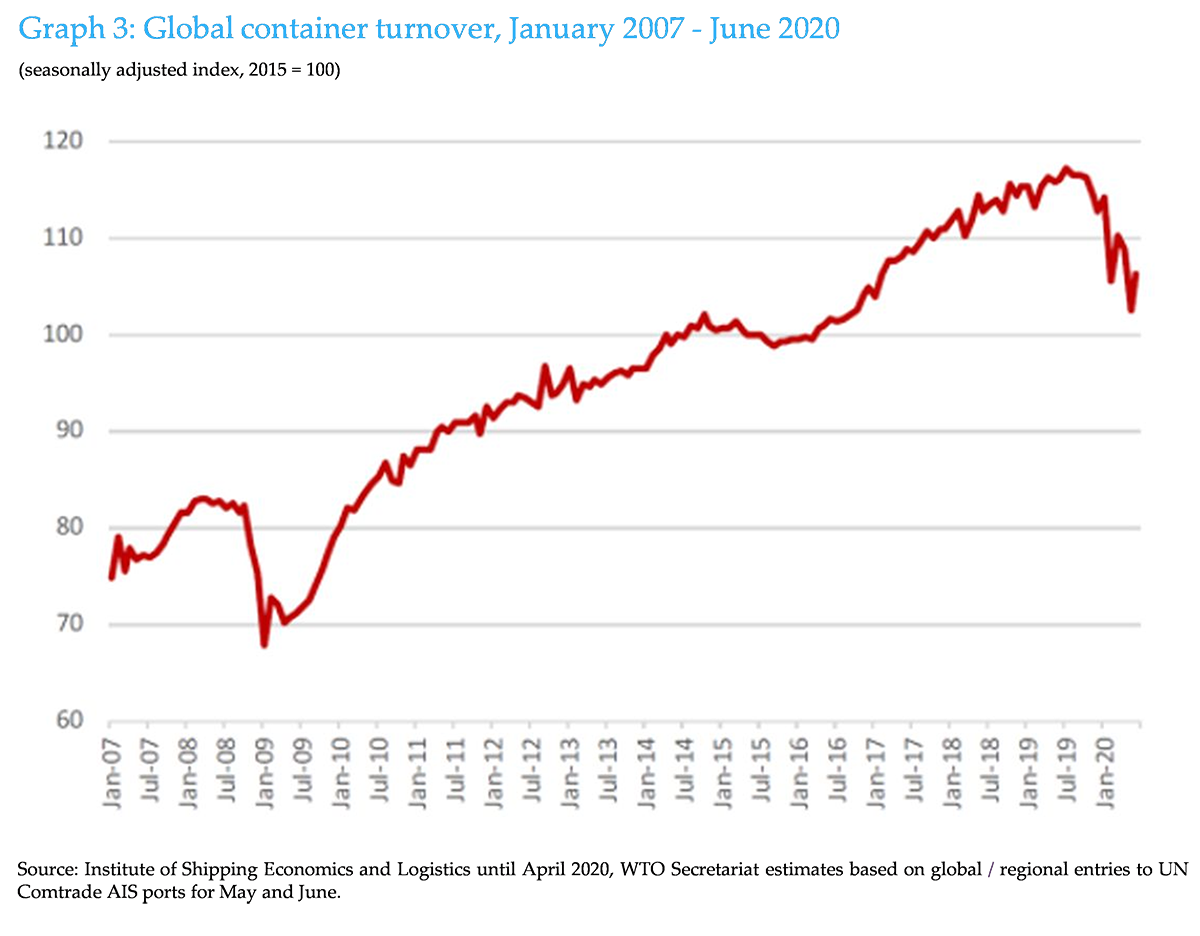
Good News From the WTO: Optimistic World Trade Development Scenario 2020
The WTO report published in late June gives rise to optimism. In April, the world Trade Organization projected two scenarios for global trade to fall in 2020, by 13%, and at worst, — by 32%. As the second quarter showed, there is a gradual improvement of the situation, and at the end of the year the market will fall by 13–14%.
Trade Indicators
The COVID-19 pandemic upended the global economy in the first half of the year. The first quarter showed a decrease in the trade indicator by 3%, while the second — by 18,5%. Historically, this is the largest decline in the history of observations since 2005. Yet, as the organization’s director-general, Roberto Azevedo, observed, — “things could have been much worse”. The fall is presumed to have reached the bottom in the second quarter of 2020, while further, trade volumes are projected to grow by 2.5% per quarter.
Given that the pessimistic scenario implied a 32% annual decline in trade, the current result could be considered relatively good. The Director-General of the WTO believes that the agreed policy decisions have mitigated the situation. If fiscal, monetary, and trade policies move in the same direction, a full recovery of trade indicators to pre-COVID levels is possible in 2021.
The COVID-19 pandemic upended the global economy in the first half of the year. The first quarter showed a decrease in the trade indicator by 3%, while the second — by 18,5%. Historically, this is the largest decline in the history of observations since 2005. Yet, as the organization’s director-general, Roberto Azevedo, observed, — “things could have been much worse”. The fall is presumed to have reached the bottom in the second quarter of 2020, while further, trade volumes are projected to grow by 2.5% per quarter.
Given that the pessimistic scenario implied a 32% annual decline in trade, the current result could be considered relatively good. The Director-General of the WTO believes that the agreed policy decisions have mitigated the situation. If fiscal, monetary, and trade policies move in the same direction, a full recovery of trade indicators to pre-COVID levels is possible in 2021.

Commercial Flights and Container Traffic
The key actions to restrict traffic were taken by most countries in the second half of March and in April. Starting in May, they have been gradually weakening. Between January 5 and April 18, the number of commercial flights carrying international cargo decreased by almost 74%, and then began to increase, and until mid-June this growth was about 58%.
By June 2020, the throughput capacity of container ports (compared to May) was partially restored. Also, after a record fall in April, indices of new export orders from purchasing managers began to increase. A positive trend is particularly important in this case, as it follows a historic downturn.
The key actions to restrict traffic were taken by most countries in the second half of March and in April. Starting in May, they have been gradually weakening. Between January 5 and April 18, the number of commercial flights carrying international cargo decreased by almost 74%, and then began to increase, and until mid-June this growth was about 58%.
By June 2020, the throughput capacity of container ports (compared to May) was partially restored. Also, after a record fall in April, indices of new export orders from purchasing managers began to increase. A positive trend is particularly important in this case, as it follows a historic downturn.

WTO experts believe that the recovery in GDP and world economic growth rates will be slow, which in turn will affect trade growth dynamics. For 2021, it is projected at 5%, which is well below the "pre-pandemic" trajectory. Yet even this pace should provide an overall increase in trade turnover by about 20% next year. That is in line with an optimistic April forecast scenario.
Governments of all countries are interested in keeping global markets open and predictable. Fiscal and credit policies were therefore deployed faster and on a larger scale versus the 2008-2009 crisis. Policy decisions taken are designed to support a favorable business environment, which is critical to encouraging new investments.
As for Russia, according to the Institute for Economics and Peace, it is among the five countries that will recover the most quickly from the crisis caused by the pandemic (a total of 163 states were analyzed). This is facilitated by low unemployment and public debt, as well as relative independence from foreign trade.
Governments of all countries are interested in keeping global markets open and predictable. Fiscal and credit policies were therefore deployed faster and on a larger scale versus the 2008-2009 crisis. Policy decisions taken are designed to support a favorable business environment, which is critical to encouraging new investments.
As for Russia, according to the Institute for Economics and Peace, it is among the five countries that will recover the most quickly from the crisis caused by the pandemic (a total of 163 states were analyzed). This is facilitated by low unemployment and public debt, as well as relative independence from foreign trade.


